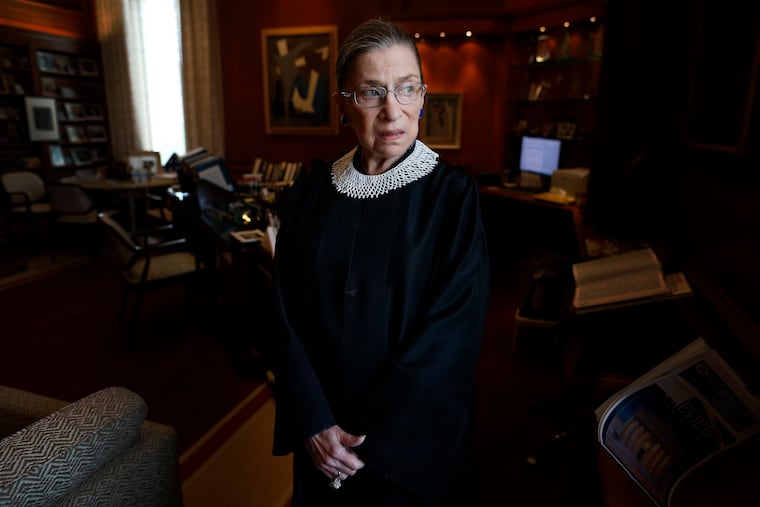Rethinking Ruth Bader Ginsburg’s legacy, a year after her death | Opinion
Ruth Bader Ginsburg’s professional demeanor and diminutive stature made her seem like an incrementalist on the Supreme Court, instead of the radical trailblazer she truly should be remembered as.

Having just passed the one-year anniversary of Justice Ruth Bader Ginsburg’s death from cancer at the age of 87, the legacy of this trailblazing advocate, scholar, and jurist remains to be determined. One theme that has emerged among the wave of feminist memes is that of the late justice as an incrementalist. But careful examination of her as a litigator and judge shows that she was anything but incremental — Justice Ginsburg was a bold change-maker who always pushed the envelope.
An incrementalist is someone who adopts a gradual approach to social change. The classic example of incrementalism was the NAACP’s strategy to overturn segregation. Rather than attack the institution directly from the start, advocates challenged particular aspects of Jim Crow over several decades, steadily chipping away at discriminatory policies and developing precedent before pursuing the big win in Brown v. Board of Education.
» READ MORE: Ruth Bader Ginsburg made the impossible look easy | Opinion
The claim that RBG was an incrementalist starts with her time as an American Civil Liberties Union litigator, when she strategically picked cases to develop the building blocks that would support her strategy against sex discrimination. And later, as a justice, she took positions that similarly did not push boundaries but rather slowly nudged the law in the direction she wanted.
This account of RBG’s incrementalism falls woefully short.
Throughout her life, Justice Ginsburg was underestimated, whether as a member of an early cohort of female law students at Harvard in the 1950s, as an unsuccessful applicant for clerkships and law firm jobs, as an oral advocate before the Supreme Court, or as a supposedly moderate appointee to the high court in 1993. Observers misinterpreted her small stature, formal demeanor, and concern for collegiality to reflect timidity, only to be surprised by Ginsburg’s fierce determination and clarion voice.
But a closer look reveals that Justice Ginsburg’s bold claims regarding sex equality do not align with the tired story of her gradualism.
Ginsburg’s signature accomplishment as a lawyer was convincing the Supreme Court to review more strictly laws that discriminate on the basis of sex. The conventional wisdom is that she, like the NAACP against Jim Crow, moved slowly to build her case piece by piece. To the contrary, however, in the first case she ever litigated, she jumped straight to arguing for the most stringent standard of review, strict scrutiny. Though the relevant precedent cut against her position, Ginsburg pushed for the most robust protection from discrimination without intermediate steps, drawing on arguments developed by trailblazing feminists before her like Pauli Murray. In dozens of briefs to the court, she never wavered. In fact, even when it was clear the court was not going to agree with her, she made the push for strict scrutiny one last time in her very last brief to the court.
» READ MORE: Should the size of the Supreme Court expand to change the ideological balance? | Pro/Con
The incrementalist assessment also claims that Ginsburg carefully planned a progression of cases to educate the all-male justices about gender discrimination. This is a fallacy. Certain cases fit that bill, but sometimes she joined only after other attorneys appealed to the court on their own. And plenty of cases she asked the court to take were never heard.
Another argument suggests Ginsburg was an incrementalist for using men as plaintiffs. It’s true that her male clients made compelling plaintiffs in several early sex discrimination lawsuits, but this represents only a small number of her cases, most of which involved women. Moreover, attacking sex discrimination on behalf of men was, especially in the 1970s, a far-reaching position. Ginsburg recognized the harm gender stereotypes inflict on everyone, a visionary argument that paved the way for LGBTQ equality in subsequent decades.
Applying the incrementalist label to RBG also conflicts with her record on the court. Even though she criticized Roe v. Wade before she was a judge, as a justice, she routinely voted against abortion restrictions. Her commitment to abortion rights as a matter of equality, the basis for her earlier critique of Roe, would actually guarantee more protection, such as a right to federal funding for abortion. In other words, her criticism of Roe was that it was not bold enough.
Other positions Ginsburg took as a justice reflect the same dynamic. She always voted for sex equality. But beyond that, on gay and trans rights, Ginsburg sided with LGBTQ litigants as a matter of course. In fact, she criticized half measures like civil unions as “skim milk” marriage.
We shouldn’t declare RBG an incrementalist based on her respect for professional norms and her gentle deftness at navigating the legal world. Rather, we should see a revolutionary thinker whose success was possible, in part, because her demeanor camouflaged the radical nature of claims.
Elizabeth Kukura is an assistant professor of law and David S. Cohen is a professor of law, both at the Thomas R. Kline School of Law at Drexel University.